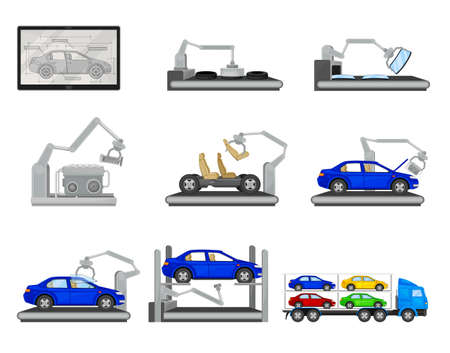1. Introduction to AI in Self-Driving Cars
Artificial intelligence (AI) plays a crucial role in enabling self-driving cars to navigate roads, recognize objects, and make real-time decisions. By using advanced sensors, machine learning algorithms, and complex data analysis, AI helps autonomous vehicles operate safely and efficiently.
How AI Powers Autonomous Vehicles
AI allows self-driving cars to process vast amounts of data from cameras, LiDAR, radar, and GPS to understand their surroundings. It enables the vehicle to detect pedestrians, other cars, traffic signs, and road conditions, ensuring smooth navigation without human intervention.
Key AI Technologies in Self-Driving Cars
| AI Technology | Function |
|---|---|
| Computer Vision | Helps the car recognize objects like pedestrians, obstacles, and traffic signs. |
| Machine Learning | Allows the vehicle to learn from past driving experiences to improve decision-making. |
| Sensor Fusion | Combines data from different sensors to create an accurate picture of the environment. |
| Decision-Making Algorithms | Enables the car to react to traffic conditions, change lanes, and avoid obstacles. |
AI’s Importance in Modern Transportation
AI-driven self-driving cars have the potential to reduce traffic congestion, lower accident rates, and provide mobility for people who cannot drive. As this technology evolves, it will significantly impact the future of transportation by making travel safer and more efficient.
2. Core AI Technologies in Autonomous Vehicles
Artificial intelligence (AI) is the driving force behind self-driving cars. These vehicles rely on several key AI technologies to perceive their surroundings, interpret data, and make intelligent driving decisions. Some of the most critical AI components include machine learning, computer vision, sensor fusion, and decision-making algorithms.
Machine Learning
Machine learning allows self-driving cars to learn from vast amounts of data collected through sensors, cameras, and real-world driving experiences. By analyzing this data, AI models can recognize patterns and improve performance over time. There are two primary learning techniques used in autonomous vehicles:
| Type of Machine Learning | Description |
|---|---|
| Supervised Learning | Uses labeled data to train algorithms. For example, it can recognize pedestrians, traffic signs, and vehicles. |
| Reinforcement Learning | Helps the AI make better decisions by rewarding successful driving behaviors and penalizing mistakes. |
Computer Vision
Computer vision enables self-driving cars to see and understand their environment. Cameras work alongside deep learning algorithms to detect objects, read traffic signs, and identify lane markings. This technology is essential for safely interacting with pedestrians, cyclists, and other vehicles.
Sensor Fusion
Autonomous vehicles use multiple sensors to gather information about their surroundings. Sensor fusion combines data from different sources to create a comprehensive view of the environment. Here are some of the key sensors used in self-driving cars:
| Sensor Type | Function |
|---|---|
| Cameras | Provide visual data for detecting objects, signs, and road conditions. |
| Lidar | Uses laser beams to create a 3D map of the surroundings, helping with object detection and distance measurement. |
| Radar | Detects larger objects and their movement, even in poor weather conditions. |
| Ultrasonic Sensors | Assist with close-range object detection, useful for parking and avoiding obstacles. |
Decision-Making Algorithms
The AI in self-driving cars must constantly make decisions based on real-time data. Decision-making algorithms process sensor inputs and determine the best actions to take. These algorithms consider factors like traffic rules, road conditions, and the behavior of other drivers to ensure safe navigation.
Types of Decision-Making Algorithms
- Rule-Based Systems: Follow predefined rules to handle common driving scenarios.
- Optimization Algorithms: Evaluate multiple driving options and select the safest and most efficient path.
- Neural Networks: Mimic human decision-making by analyzing vast amounts of driving data to improve performance.
Why AI is Critical for Self-Driving Cars
AI enables autonomous vehicles to continuously learn and adapt to changing road conditions. By integrating machine learning, computer vision, sensor fusion, and advanced decision-making, self-driving cars can navigate safely and efficiently without human intervention.

3. How AI Enhances Safety and Efficiency
Artificial Intelligence (AI) plays a crucial role in improving road safety and driving efficiency in self-driving cars. By utilizing advanced sensors, real-time data processing, and machine learning, AI helps reduce accidents, optimize traffic flow, and enhance overall driving experience.
Reducing Accidents with AI
AI-powered self-driving cars use a combination of cameras, lidar, radar, and GPS to continuously monitor their surroundings. These systems allow vehicles to detect obstacles, predict potential collisions, and take proactive measures to avoid accidents.
Accident Prevention Technologies
| AI Technology | Function |
|---|---|
| Collision Avoidance Systems | Detects obstacles and applies emergency braking if necessary |
| Lane-Keeping Assist | Ensures vehicles stay within designated lanes |
| Predictive Analytics | Analyzes driving patterns to anticipate risky situations |
| Pedestrian Detection | Recognizes humans and animals to prevent accidents |
Optimizing Traffic Flow
Self-driving cars use AI to analyze traffic patterns, road conditions, and real-time data from other connected vehicles. This enables them to adapt speed, take efficient routes, and reduce unnecessary stops, leading to smoother traffic flow and shorter travel times.
Real-Time Traffic Management
- AI analyzes congestion levels and suggests alternative routes.
- Vehicle-to-Vehicle (V2V) communication helps cars coordinate movement.
- Traffic signal prediction minimizes delays at intersections.
Enhancing Driving Efficiency
AI enables self-driving cars to optimize fuel consumption, reduce energy waste, and provide a more comfortable ride. By adjusting acceleration, braking, and route planning intelligently, AI ensures a smoother and safer driving experience.
Benefits of AI in Driving Efficiency
- Reduces fuel consumption by optimizing speed and braking.
- Minimizes wear and tear on vehicle components.
- Enhances battery efficiency in electric and hybrid vehicles.
With continuous advancements in AI, self-driving cars are becoming safer and more efficient, paving the way for a future with fewer accidents and improved road conditions.
4. Challenges and Ethical Considerations
As artificial intelligence (AI) continues to advance in self-driving cars, several challenges and ethical concerns arise. These issues span from technological limitations to legal and moral dilemmas. Below, we analyze some of the most pressing concerns in the development and deployment of autonomous vehicles.
Technological Challenges
Even with cutting-edge AI, self-driving cars face obstacles that hinder their widespread adoption. Some of these include:
- Sensor Reliability: Cameras, LiDAR, and radar must work flawlessly in all weather conditions.
- Software Complexity: AI must correctly interpret real-world scenarios, including unpredictable human behavior.
- Cybersecurity Risks: Autonomous vehicles are vulnerable to hacking and software manipulation.
Legal and Liability Issues
Who is responsible when a self-driving car is involved in an accident? This remains a major legal challenge.
| Scenario | Possible Liable Party |
|---|---|
| Software malfunction leads to a crash | Car manufacturer or software developer |
| Sensor failure causes a misjudgment | Hardware supplier or automaker |
| Human driver fails to take control | Vehicle owner or operator |
Data Privacy Concerns
Self-driving cars collect vast amounts of data, including location, driving habits, and even passenger conversations. Protecting user data from misuse is a significant challenge. Regulators and manufacturers must work together to ensure:
- Encryption of sensitive data.
- Clear policies on data sharing.
- Compliance with data protection laws.
Ethical Decision-Making in AI
One of the biggest concerns with autonomous vehicles is how they make ethical decisions in unavoidable accident scenarios. If a collision is imminent, should the AI prioritize the safety of the passenger or pedestrians? This ethical dilemma is known as the “trolley problem.”
Possible AI Decision Approaches
- Utilitarian: Minimize overall harm, even if it sacrifices the car’s occupant.
- Passenger Priority: Always prioritize the vehicle’s occupants over others.
- Random Decision: Let chance determine the outcome in unpredictable crashes.
Public Trust and Acceptance
For self-driving cars to succeed, the public must trust AI-driven decision-making. Transparency in how these decisions are programmed and implemented will be crucial for widespread acceptance.
5. Five. The Future of AI in Autonomous Driving
Predictions and Trends in AI-Driven Self-Driving Cars
The future of self-driving cars is closely tied to advancements in artificial intelligence. As technology evolves, we can expect more sophisticated AI models, changes in regulations, and broader societal acceptance. Here’s a look at what lies ahead for AI-powered autonomous vehicles.
Advancements in AI Models
AI models are getting smarter and more efficient. With improvements in deep learning, sensor fusion, and real-time decision-making, self-driving cars will become safer and more reliable. Some key advancements include:
| AI Advancement | Impact on Autonomous Driving |
|---|---|
| Reinforcement Learning | Improves self-learning capabilities, allowing cars to adapt to new driving conditions. |
| Neural Network Optimization | Enhances vehicle perception, leading to better hazard detection and reaction times. |
| Edge AI Processing | Reduces latency by enabling real-time decision-making within the vehicle. |
Regulatory Developments
As AI technology advances, governments and regulatory bodies are working to establish clear guidelines. These regulations aim to ensure safety and public trust while fostering innovation. Some key developments include:
- Unified Safety Standards: Establishing global benchmarks for AI-driven self-driving technology.
- Data Privacy Regulations: Defining how autonomous vehicles collect and use passengers data.
- Legal Liability Frameworks: Clarifying responsibility in the event of an accident involving self-driving cars.
Societal Impact of AI in Self-Driving Cars
AI-powered self-driving cars have the potential to transform daily transportation, impacting society in multiple ways:
Increased Accessibility
Self-driving cars could provide mobility solutions for the elderly and disabled, allowing them to travel safely and independently.
Reduced Traffic Accidents
With AI-driven decision-making and vehicle-to-vehicle communication, accidents caused by human error could decline significantly.
Changes in Employment
While automation in transportation may reduce jobs in driving-related industries, it could also create new opportunities in AI development and vehicle maintenance.
The future of AI in autonomous driving remains promising. As technology matures, regulations adapt, and society embraces change, self-driving cars will become an integral part of our daily lives.

